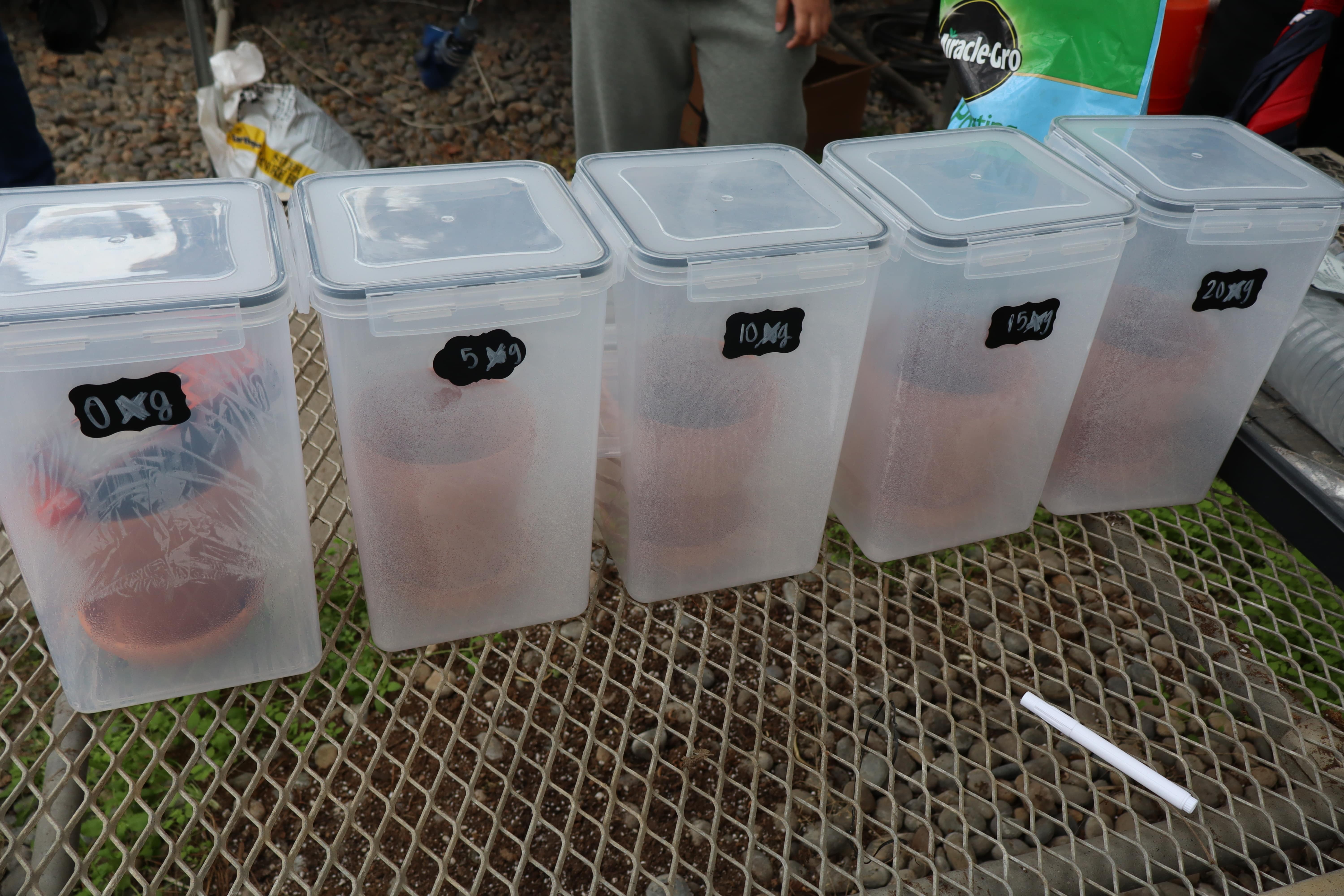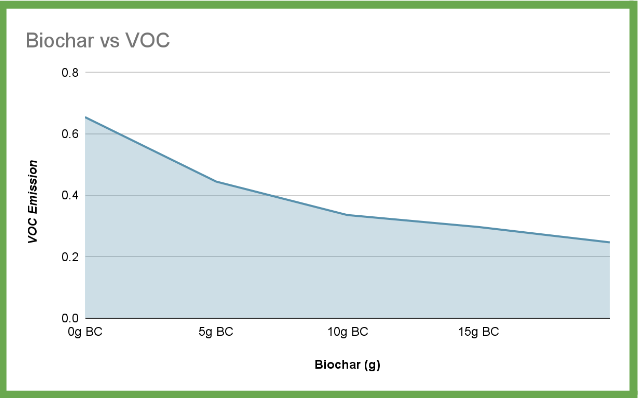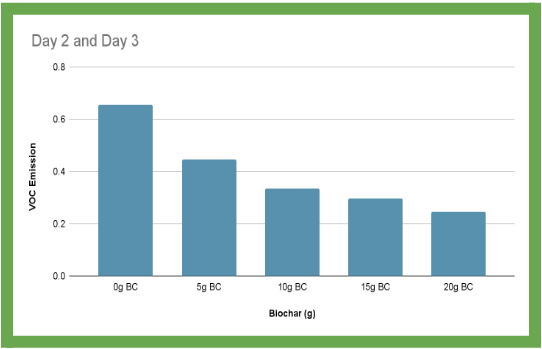Department of Earth and Environmental Sciences
Biochar & VOC
In this student-led research regarding Biochar & VOC, this study will reinforce the usage of "field-plotting" (the practice of physically marking out specific areas within a field to conduct research experiments) and evaluate how biochar can be beneficial to many areas around the world, such as the Central Valley, by its properties of reducing and even trapping "VOC" volatile organic compound emissions.
The Process of The Experiment
(All thanks to CSM BOND Students Anjali, Fiona, Matt, and Richard)

VOCs commonly surround our atmosphere, leaving the Central Valley and many highly prone areas with unhealthy emissions of this pollutant. To decrease VOC emissions and improve soil health in these areas, this research group plans to investigate if biochar and field-plotting may be an eco-friendly solution. First, they scouted areas that may prove to have high VOC emissions before gathering five clay pots (measured 5 inches) and labeling them from 1 to 5 along with the amount of biochar measured in grams.

Afterwards, they placed the same amount of soil from each plot of land into the corresponding clay pot. Then, they measured the amount of biochar needed for each sample and kept it in a separate container. (Each pot increases by 5 mg) So with this, Sample 1 should contain 0 mg of biochar, and Sample 2 should contain 5 mg of biochar. Sample 3 should contain 10 mg of biochar, while Sample 4 should contain 15 mg of biochar and Sample 5 should contain 20 mg of biochar.

For their evaluations, this group places each clay pot into each plastic box before inserting the VOC emissions measurer. After that, they securely place the box's lid back on and wait fifteen minutes for the measurer to detect any VOC emissions the soil initially releases before applying biochar. Once the timer for fifteen minutes is up, the group goes on to record how many emissions have been released as their initial emission level. They then repeat these procedures for the remaining pots four to five times a week.
Methods
In order to achieve optimal and desirable results for this group's research, these student researchers have used the following equipment and resources to gather their data.
Location:
Soil samples are collected from the Science II building in Fresno State University. The samples were taken from a plot of soil in the center of the building's courtyard.
The research and development of this project took place in the Fresno State Greenhouse, just outside of the Science II Building.
Equipment and Material:
- VOC Emission Measurer(s)
- (5) Plastic Boxes
- (5) Clay Pots
- Biochar
- Soil
Essential Information
What is VOC?
"VOC", also known as volatile organic compounds, are pollutants that are commonly found in many day-to-day usage (gasoline, diesel fuel, carpets, paints, cleaners, etc.) These pesky pollutants can be also seen in the manufacturing of automobiles, electronics, dyes, rubber products, and plastics---or even soil itself. All of these things are found and used in our everyday lives, which causes a widespread problem of these VOC emissions in concern to human health and agricultural issues. There's a limit to where these pollutants can emit too much and especially become dangerous.
So, how will this experiment take place?
To start off this experiment, this notable group will be determining how much VOC is emitted from soil, which will be experimented by soil (with compost in it already) that is collected off of Fresno State's campus. They're aiming to see how much VOC is inside of the soil initially and evaluating if biochar really does reduce VOC emissions that are released out into the air.
All of these questions are concerning how VOC can show negative side effects:
How Is This Impacting Agriculture?
VOCs stimulate diseases in plants, inhibit seed production, and delay fertilization, which unfortunately affects the productivity of crop growth and quality.
**From where we are located in the Central Valley, Fresno is very reliant on farming, in which this issue is a huge deal to especially those in agriculture---as we do need these resources to produce quality food.
What Are Some Health Risks?
In exposure to high quantities of VOC, this can be harmful to human beings. For instance, it can cause headaches, dizziness, memory loss, and visual impairment. Communities who are especially around this, such as farm workers and low-incomes families, are more prone to being negatively affected by this.
How Does This Relate To Our Water?
VOCs could actually pollute groundwater, which isn't good for our community. This can spoil water quality, livestock, and public health.
What Are The Economic Consequences To This?
Unfortunately from this impact, the decrease in agricultural productivity affects Fresno's farmers due to the high expenses of soil remediation and water sources.

Biochar & VOC Graph Analysis
Results of Biochar & VOC represented in various graphs, exhibiting the benefits of biochar application in soil.
Get Overview of Biochar & VOC Graph Analysis Results
Biochar & VOC Data Overview
Data overview of Biochar & VOC, exhibiting discussions and discoveries out of this experiment.
Get Data overview of Biochar & VOC ResultsLimitations & Suggestions
Limitations:
If this group were to do something differently, they hoped to obtain a soil sample from a higher VOC emission plot of soil. This is because they had initially obtained a sample from a "greener" area, which caused them to have low VOCs---this makes the measurement of value changes very hard. They considered obtaining a sample next to a parking lot so that it may be a more reliable sample in giving higher VOC emissions.
Suggestions:
Farmers are definitely encouraged to utilize biochar through incentives and agricultural programs. There should also be support for giving carbon credits to farmers who use biochar to grow their crops.
This group hopes that this work may continue; the concepts regarding these issues should expand. They believe that better materials would've helped finalize results in this study and provide more specific details on what's happening within the soil. A longer timeline would've also been helpful since there was a time constraint due to the semester wrapping up. The more research on this, the more the discoveries and the stronger the claims.
Credits
Notable Bond Researchers: Website Coordinator:
Alexis Alexxa Aurio
Eema
Jeffrey
Triston
Fellow Student Researchers:
Anjali Patel
Fiona Iberdemaj
Matt Dougan
Richard Quesada